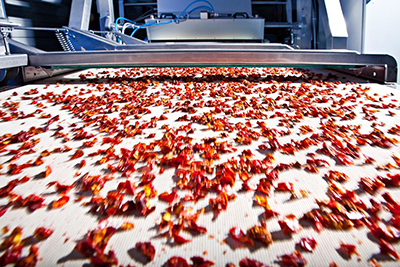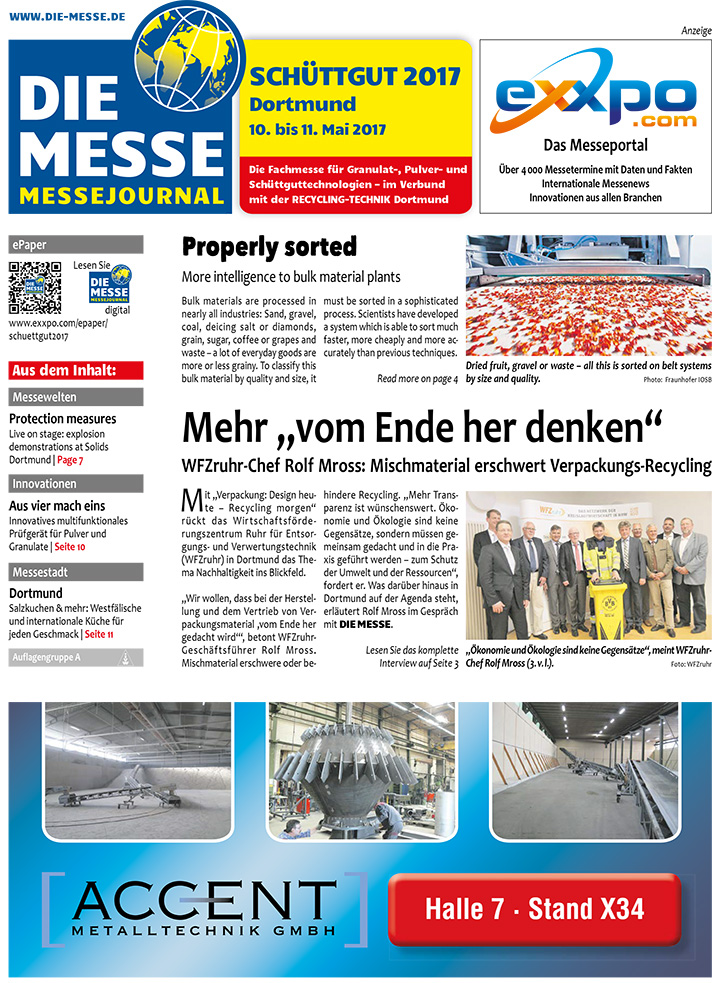9 May 2017
Bulk materials are processed in nearly all industries, be it building construction, logistics, chemistry or agriculture. Given the large number of plants, any improvement of the sorting steps necessary everywhere could save billions. “The economic benefit of this project can hardly be overestimated; enormous resources could be saved,” explains Professor Uwe Hanebeck of the Chair of Intelligent Sensor – Actuator Systems (ISAS) at the KIT in describing the new technology.
Because of the patterns of movement of objects to be sorted, much more precise classification is possible than in conventional sorting systems. Industry had already shown interest in the new technology, says Professor Thomas Längle, responsible for the project at the Fraunhofer IOSB. “Classical belt-type sorting systems scan the material to be sorted by means of a camera; parts not to be treated are blown out by means of pressurized-air nozzles,” explains Georg Maier of the IOSB.
Different perspectives
There is a problem: The cameras now in use scan the objects only on a short belt section, which allows only rough classification. As a consequence, several runs are necessary to achieve a satisfactory result. The team around Längle and Hanebeck developed a sorting system in which cameras operating from different perspectives take a more precise view of the bulk material. In this way, objects of different categories can be distinguished more effectively.
In addition, algorithms based on the images predict how objects are going to move on the belt. In this way, it is possible to sort out foreign bodies much more precisely. The advantages of the new sorting system are explained by Benjamin Noack of the ISAS by the example of spheres and hemispheres: “When seen from the top, they look alike. While hemispheres normally remain on the belt, spheres are restless, thus additionally aggravating the sorting process. However, when seen from the side, spheres and hemispheres can be distinguished.”
In addition, the system was now able to predict the behavior of these objects and then adjust its operation accordingly and, in this way, also achieve better classification, says Noack. The scientists also found a way to increase the accuracy of existing sorting systems quickly and at low cost. “But this requires a software update,” explains Hanebeck. Besides the KIT and IOSB, also the Ruhr University of Bochum (RUB) and the Technical University of Berlin (TUB) are involved in the project. Scientists at those institutions in particular work on realistic simulations of bulk material and the numerical design of sorting systems.
Properly sorted: more intelligence to bulk material plants
Bulk materials are processed in nearly all industries: Sand, gravel, coal, deicing salt or diamonds, grain, sugar, coffee or grapes and waste – a lot of everyday goods are more or less grainy. To classify this bulk material by quality and size, it must be sorted in a sophisticated process. Scientists have developed a system which is able to sort much faster, more cheaply and more accurately than previous techniques.
 Photo: Fraunhofer IOSB Photo: Fraunhofer IOSBDried fruit, gravel or waste – all this is sorted on belt systems by size and quality. |
Because of the patterns of movement of objects to be sorted, much more precise classification is possible than in conventional sorting systems. Industry had already shown interest in the new technology, says Professor Thomas Längle, responsible for the project at the Fraunhofer IOSB. “Classical belt-type sorting systems scan the material to be sorted by means of a camera; parts not to be treated are blown out by means of pressurized-air nozzles,” explains Georg Maier of the IOSB.
Different perspectives
There is a problem: The cameras now in use scan the objects only on a short belt section, which allows only rough classification. As a consequence, several runs are necessary to achieve a satisfactory result. The team around Längle and Hanebeck developed a sorting system in which cameras operating from different perspectives take a more precise view of the bulk material. In this way, objects of different categories can be distinguished more effectively.
In addition, algorithms based on the images predict how objects are going to move on the belt. In this way, it is possible to sort out foreign bodies much more precisely. The advantages of the new sorting system are explained by Benjamin Noack of the ISAS by the example of spheres and hemispheres: “When seen from the top, they look alike. While hemispheres normally remain on the belt, spheres are restless, thus additionally aggravating the sorting process. However, when seen from the side, spheres and hemispheres can be distinguished.”
In addition, the system was now able to predict the behavior of these objects and then adjust its operation accordingly and, in this way, also achieve better classification, says Noack. The scientists also found a way to increase the accuracy of existing sorting systems quickly and at low cost. “But this requires a software update,” explains Hanebeck. Besides the KIT and IOSB, also the Ruhr University of Bochum (RUB) and the Technical University of Berlin (TUB) are involved in the project. Scientists at those institutions in particular work on realistic simulations of bulk material and the numerical design of sorting systems.
| FAIR NAVIGATOR | |||||||||
|---|---|---|---|---|---|---|---|---|---|
|
| E-PAPER SCHüTTGUT DORTMUND |
 |
